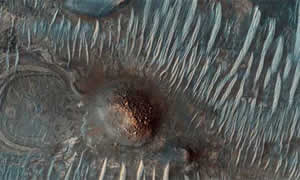The 13C isotope
Giant plumes of methane on Mars may be the belches of buried microbes
NASA is keeping an open mind, but says there is an urgent need to analyse the methane clouds for other chemicals that would either confirm or rule out life as the cause.
This was the headline for an article published in the Guardian on Thursday 15th of January 2009.
The picture on the right is from www.guardian.co.uk

Nili Fossae, one of the regions on Mars emitting methane. The area was already a proposed landing site for the Mars Science Laboratory because of the presence of mineral-rich clays (red). Photograph: AP/Nasa
In 2011 NASA launched the Mars Science Laboratory(MSL), pictured on the right.
But how to deduce whether the methane present is from an organic rather than an inorganic source?
